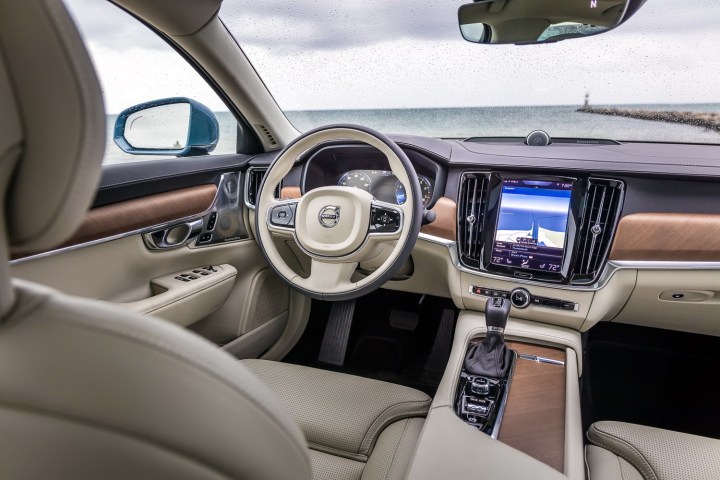 Advanced driver-assist systems like Tesla’s Autopilot and Volvo’s Pilot Assist are often touted as the cutting edge of safety tech, and possibly a stepping stone to self-driving cars. But in a recent test of these systems, the Insurance Institute for Highway Safety (IIHS) found their real-world performance to be lacking.
Advanced driver-assist systems like Tesla’s Autopilot and Volvo’s Pilot Assist are often touted as the cutting edge of safety tech, and possibly a stepping stone to self-driving cars. But in a recent test of these systems, the Insurance Institute for Highway Safety (IIHS) found their real-world performance to be lacking.
“Evaluations of adaptive cruise control and active lane-keeping show variable performance in typical driving situations, such as approaching stopped vehicles and negotiating hills and curves,” an IIHS statement said. “The early results underscore the fact that today’s systems aren’t robust substitutes for human drivers.”
Adaptive cruise control can automatically vary speed based on the car in front, slowing down when the lead car slows and accelerating when appropriate. What the IIHS refers to as active lane-keeping systems allow the car to steer itself to a certain degree in order to stay centered in a lane. The ability of these systems to manipulate steering, acceleration, and parking, has led some media reports to describe them as enabling fully autonomous driving, but that is not the case. These systems still require an attentive human driver.
For its test, the IIHS selected a 2017 BMW 5 Series equipped with Driving Assistant Plus, a 2017 Mercedes-Benz E-Class with Drive Pilot, a Tesla Model 3 and Tesla Model S equipped with Autopilot (software versions 8.1 and 7.1, respectively), and a 2018 Volvo S90 with Pilot Assist. All five cars also had autonomous emergency braking systems that received the IIHS’ top rating of “Superior.”
Testers evaluated the cars on a closed course and on public roads. While the adaptive cruise control systems performed fairly well under controlled conditions, performance can vary in the real world, the IIHS said. On the test track, the BMW, Mercedes, and Teslas braked to avoid a completely stopped target vehicle, even though some vehicles’ owners’ manuals specifically said adaptive cruise control may not recognize a vehicle that has already stopped. Sure enough, on a real-world road, IIHS senior research engineer Jessica Jermakian found that the E-Class did not identify a pickup truck stopped at a red light. She had to apply the brakes manually.
“At IIHS we are coached to intervene without warning, but other drivers might not be as vigilant,” Jermakian said in a statement. “ACC [adaptive cruise control] systems require drivers to pay attention to what the vehicle is doing at all times and be ready to brake manually.”
Testers also noted “unnecessary or overly cautious braking” to be an issue with the Model 3. Over 180 miles, the car unexpectedly braked 12 times, according to the IIHS. Seven of those instances were for tree shadows, the rest for oncoming vehicles in another lane, or vehicles crossing the road far ahead. Jermakian said this quirk “didn’t create unsafe conditions” because the car didn’t brake very hard, but noted that erratic braking may cause owners to lose confidence in Autopilot.
But the Model 3 was also the only car to stay centered in its lane in every active lane-keeping test for curves. The Model S overcorrected on one curve, causing it to cross the inside line in one turn. The E-Class and S90 both stayed within the lane in nine of 17 runs, while the 5 Series could only keep itself in a lane in three of 16 runs.
The IIHS also tested active lane-keeping on hills. Testers noted that the systems were “sometimes flummoxed” by hills because they obscure lane markings. The Model 3 once again had the best score, staying in its lane in all but one trial, where it “hugged the line.” In contrast, the 5 Series failed to stay in its lane in all 14 runs. Testers also noted that the Model S had a propensity to swerve while cresting a hill, as it apparently lost track of lane markings. The car “rarely” warned drivers to take over in these situations, the IIHS said. It shows that drivers have to remain vigilant.
“We’re not ready to say yet which company has the safest implementation … but it’s important to note that none of these vehicles is capable of driving safely on its own,” IIHS chief research officer David Zuby said in a statement. “A production autonomous vehicle that can go anywhere, anytime isn’t available at your local car dealer and won’t be for quite some time. We aren’t there yet.”


